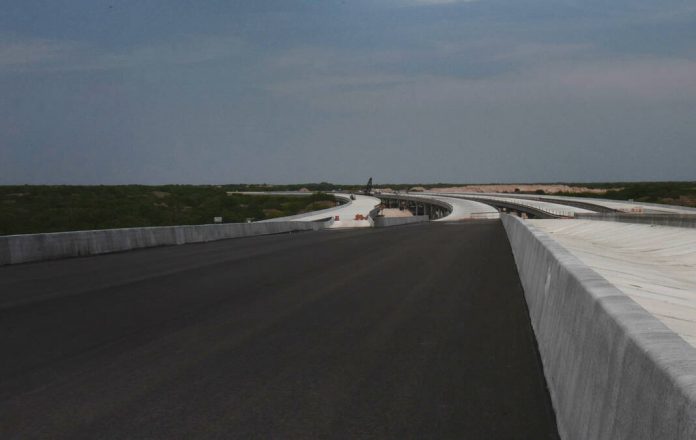|
Only have a minute? Listen instead
Getting your Trinity Audio player ready...
|
The Texas Department of Transportation touted this week the progress it’s made on its second largest project in the district — a $196 million project that will extend Interstate 2 by nine miles in the western part of Hidalgo County.
Officially named the U.S. Relief Route, the project is meant to alleviate traffic in the La Joya and Peñitas area by extending the highway from Palmview to Sullivan City, meaning faster transportation of goods and people.
Once completed,drivers on U.S. 83 will have the option to go around La Joya’s business district on the newly constructed expressway bypass.
The Relief Route is the second largest construction project for the TxDOT Pharr District, with the I-2/I-69C Interchange Project being the largest.
“One of the reasons we wanted to show it to you today is that a lot of people traveling through this part of U.S. 83, they see the connectors at the end of the project, but they don’t appreciate all the work that has already been done on the frontage roads and main lanes through the mile long stretch of the bypass,” TxDOT Public Information Officer Ray Pedraza said Wednesday.
The roadway will run through La Joya Lake, a 342-acre body of water just west of La Joya High School on Jara Chinas Road.
In order to construct a road there, engineers created temporary dirt roads that run across the lake and took steps to not damage the lake’s natural water current.
“During construction, we try to make sure we maintain the same flow rate … and we try to disturb the environment as little as possible,” TxDOT’s Director of Construction Daniel Garcia said. “Whenever the project is fully constructed then it’ll go back to its original condition.”
There’s currently a pool of water between the two artificial roads which were created in order to construct the support beams for the new route. There are also turbidity curtains being used to prevent the water from eroding the dirt roads, one of the many tools used to create a road above water.
Garcia also added crews installed pipes under the roads in order to keep the natural flow of the water.
Construction over the lake, however, is not the only place where engineers needed to be environmentally conscious.
Construction on Tom Gill Road in Peñitas included what Garcia called a “sound wall.”
“When you install a new highway, there’s potential there might be an increase in noise,” Garcia said. “So, during the environmental process, we assess if there’s going to be excess noise that might pose an issue for those who live adjacent to the project.”
Garcia added that property owners were notified about the sound wall and involved in the process, noting that had any of them decided against or were opposed to the construction of the wall, it wouldn’t be built.
Crews are also creating a wildlife crossing on the western end of the project.
“For our TxDOT projects, we do this if we know that there’s a need for it,” Garcia said about the wildlife crossing. “It’s part of the environmental process where we try to identify where those needs might need to occur.”
The currently unfinished wildlife crossing is a small tunnel that will run across the new roads. It will be fenced and contain a paved walkway surrounded by brush and rocks.
According to Garcia, Phase I of the Relief Route project, which is west of Farm-to-Market Road 2221, is about 77% complete, Phase II, or work on the east side of the project, is roughly 89% complete, and Phase III is about 77% complete.
In total the corridor is nearly 85% complete and TxDOT estimates the project will be completed in the Spring 2 next year.




